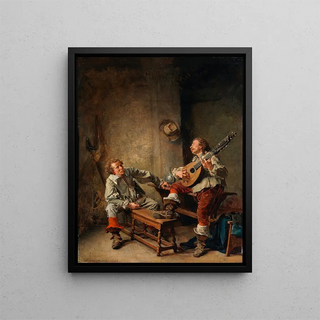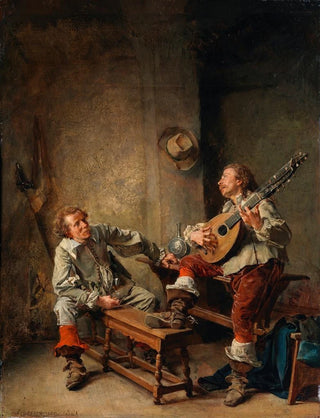Art print | A song - Ernest Meissonier


View from behind

Frame (optional)
In the vast panorama of art history, certain works stand out for their ability to capture fleeting moments and evoke deep emotions. "Une chanson" by Ernest Meissonier is a striking example. This piece, both intimate and universal, immerses us in a world where music and daily life intertwine, revealing the beauty of simple moments. Observing this scene, the viewer is transported to an universe where each note seems to vibrate in the air, where every face tells a story. Meissonier's technical mastery, combined with his keen sense of visual storytelling, makes this work a true masterpiece of the 19th century.
Style and uniqueness of the work
The work "Une chanson" is distinguished by its realistic style, characteristic of Meissonier. The artist excels in depicting details, whether it be the expressions of the characters or the textures of their clothing. Every element of the composition is carefully orchestrated to create a lively and authentic atmosphere. Light plays a crucial role, subtly illuminating the faces of the singers and bathing the rest of the scene in a gentle shadow. This skillful use of light and shadow enhances the emotion emanating from the piece, inviting the viewer to feel the melody floating in the air. The dynamic between the characters, their gestures, and their gazes transcends the simple painting to become a true representation of conviviality and shared joy.
The artist and his influence
Ernest Meissonier, born in 1815, is one of the most emblematic artists of the realist movement. His career, marked by meticulous attention to detail and a passion for depicting everyday life, profoundly influenced his contemporaries and subsequent generations. As a painter and illustrator, Meissonier captured the spirit of his time, blending elegance and authenticity. His work was also characterized by a pronounced interest in history, but it is in his genre scenes, like "Une chanson," that he truly shined. Meissonier's ability to evoke emotions through seemingly mundane scenes testifies to his artistic genius. His influence

Matte finish

View from behind

Frame (optional)
In the vast panorama of art history, certain works stand out for their ability to capture fleeting moments and evoke deep emotions. "Une chanson" by Ernest Meissonier is a striking example. This piece, both intimate and universal, immerses us in a world where music and daily life intertwine, revealing the beauty of simple moments. Observing this scene, the viewer is transported to an universe where each note seems to vibrate in the air, where every face tells a story. Meissonier's technical mastery, combined with his keen sense of visual storytelling, makes this work a true masterpiece of the 19th century.
Style and uniqueness of the work
The work "Une chanson" is distinguished by its realistic style, characteristic of Meissonier. The artist excels in depicting details, whether it be the expressions of the characters or the textures of their clothing. Every element of the composition is carefully orchestrated to create a lively and authentic atmosphere. Light plays a crucial role, subtly illuminating the faces of the singers and bathing the rest of the scene in a gentle shadow. This skillful use of light and shadow enhances the emotion emanating from the piece, inviting the viewer to feel the melody floating in the air. The dynamic between the characters, their gestures, and their gazes transcends the simple painting to become a true representation of conviviality and shared joy.
The artist and his influence
Ernest Meissonier, born in 1815, is one of the most emblematic artists of the realist movement. His career, marked by meticulous attention to detail and a passion for depicting everyday life, profoundly influenced his contemporaries and subsequent generations. As a painter and illustrator, Meissonier captured the spirit of his time, blending elegance and authenticity. His work was also characterized by a pronounced interest in history, but it is in his genre scenes, like "Une chanson," that he truly shined. Meissonier's ability to evoke emotions through seemingly mundane scenes testifies to his artistic genius. His influence






